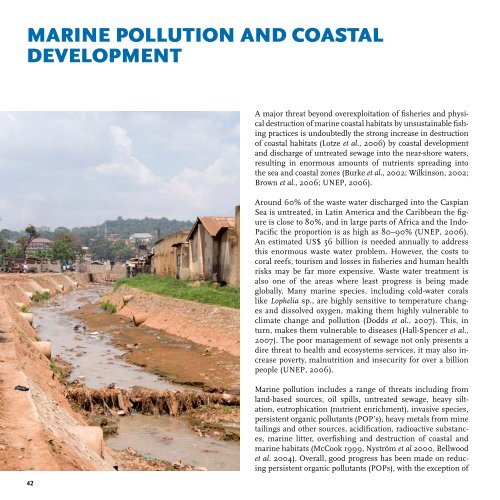In Dead Water: Merging of climate change with - UNEP
In Dead Water: Merging of climate change with - UNEP
In Dead Water: Merging of climate change with - UNEP
You also want an ePaper? Increase the reach of your titles
YUMPU automatically turns print PDFs into web optimized ePapers that Google loves.
MARINE POLLUTION AND COASTAL<br />
DEVELOPMENT<br />
A major threat beyond overexploitation <strong>of</strong> fisheries and physical<br />
destruction <strong>of</strong> marine coastal habitats by unsustainable fishing<br />
practices is undoubtedly the strong increase in destruction<br />
<strong>of</strong> coastal habitats (Lotze et al., 2006) by coastal development<br />
and discharge <strong>of</strong> untreated sewage into the near-shore waters,<br />
resulting in enormous amounts <strong>of</strong> nutrients spreading into<br />
the sea and coastal zones (Burke et al., 2002; Wilkinson, 2002;<br />
Brown et al., 2006; <strong>UNEP</strong>, 2006).<br />
Around 60% <strong>of</strong> the waste water discharged into the Caspian<br />
Sea is untreated, in Latin America and the Caribbean the figure<br />
is close to 80%, and in large parts <strong>of</strong> Africa and the <strong>In</strong>do-<br />
Pacific the proportion is as high as 80–90% (<strong>UNEP</strong>, 2006).<br />
An estimated US$ 56 billion is needed annually to address<br />
this enormous waste water problem. However, the costs to<br />
coral reefs, tourism and losses in fisheries and human health<br />
risks may be far more expensive. Waste water treatment is<br />
also one <strong>of</strong> the areas where least progress is being made<br />
globally. Many marine species, including cold-water corals<br />
like Lophelia sp., are highly sensitive to temperature <strong>change</strong>s<br />
and dissolved oxygen, making them highly vulnerable to<br />
<strong>climate</strong> <strong>change</strong> and pollution (Dodds et al., 2007). This, in<br />
turn, makes them vulnerable to diseases (Hall-Spencer et al.,<br />
2007). The poor management <strong>of</strong> sewage not only presents a<br />
dire threat to health and ecosystems services, it may also increase<br />
poverty, malnutrition and insecurity for over a billion<br />
people (<strong>UNEP</strong>, 2006).<br />
Marine pollution includes a range <strong>of</strong> threats including from<br />
land-based sources, oil spills, untreated sewage, heavy siltation,<br />
eutrophication (nutrient enrichment), invasive species,<br />
persistent organic pollutants (POP’s), heavy metals from mine<br />
tailings and other sources, acidification, radioactive substances,<br />
marine litter, overfishing and destruction <strong>of</strong> coastal and<br />
marine habitats (McCook 1999, Nyström et al 2000, Bellwood<br />
et al. 2004). Overall, good progress has been made on reducing<br />
persistent organic pollutants (POPs), <strong>with</strong> the exception <strong>of</strong>

















